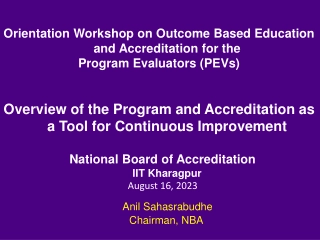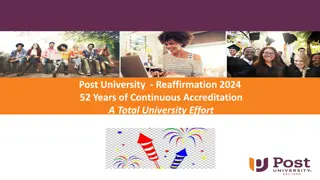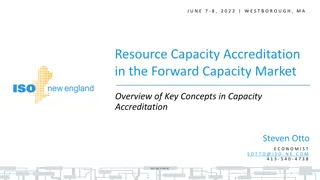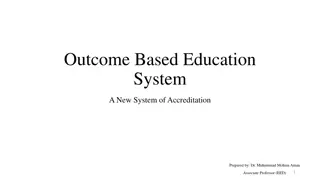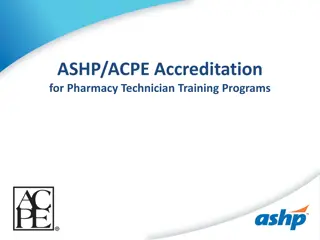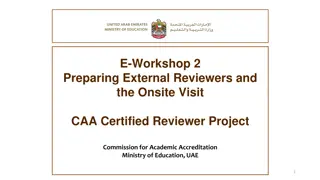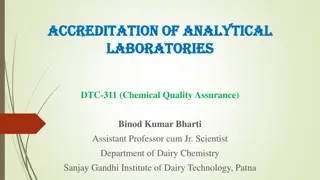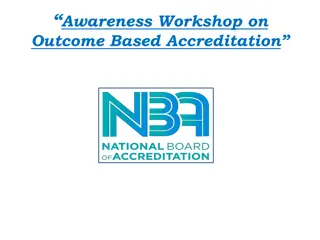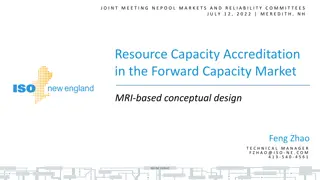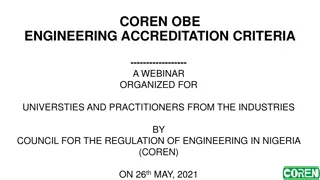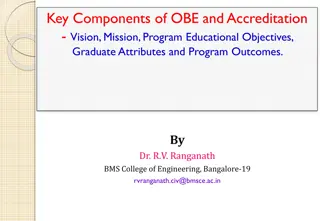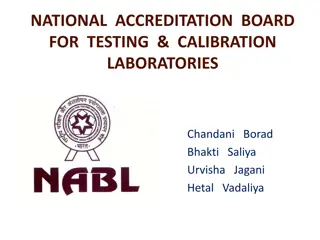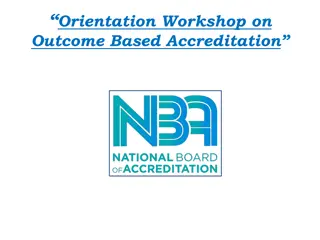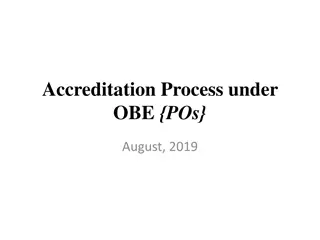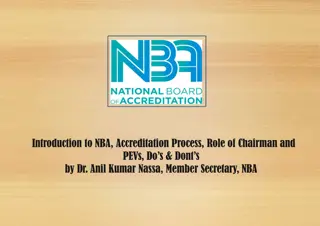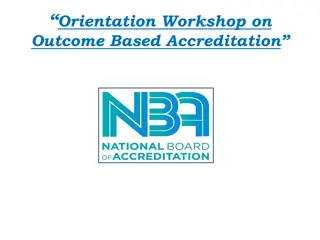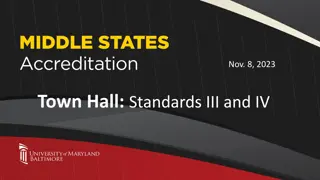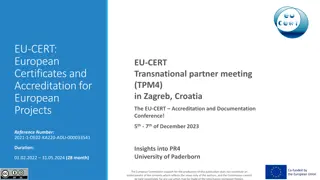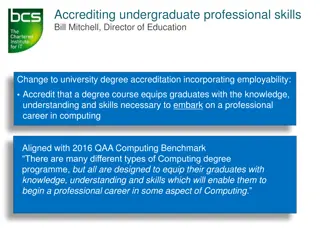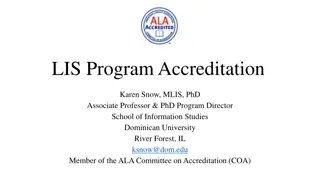Understanding Outcome-Based Accreditation for Educational Institutions
Gain insights into the importance of accreditation for educational institutions and the continuous improvement process it entails. Today's program focuses on Outcome-Based Accreditation, providing essential knowledge and tools for faculty and institution heads. Speakers include experts from the National Board of Accreditation.
Download Presentation

Please find below an Image/Link to download the presentation.
The content on the website is provided AS IS for your information and personal use only. It may not be sold, licensed, or shared on other websites without obtaining consent from the author. Download presentation by click this link. If you encounter any issues during the download, it is possible that the publisher has removed the file from their server.
E N D
Presentation Transcript
Objectives of Orientation Program An Overview of the Day
Outcomes as an Objective of Teaching As teachers, we implicitly know why we are teaching, and with what objective. Broadly we teach with a view to create understanding and insights. In real life, the insight must lead to empowerment: through knowledge, skills, attitude and behavior: Outcomes. Implicitly we know this, but rarely stop to check whether that is really happening. Outcomes Based Education: Essentially teaching with this awareness and associated effort.
Accreditation: A simple definition It is a Process by which: The Institution being looked at is given a SEAL of approval by stakeholders in its activity - as meeting their expectations. (Stakeholders: Students, Govt., Industry, Faculty, )
Request from an old IITK Student Good afternoon, My name is Suganandha Bharathi and I am a Malaysian Citizen. I had done my B.Tech in Mechanical Engineering from Indian Institute of Technology Kanpur and graduated in the year 1997. Until now I am unable to become graduate member with Board of Engineers Malaysia because IIT programmes are not accrediated or recognised by NBA india. I hope you could advice me on this matter. Thank you Suganandha Bharathi
Beyond Certification However, its aim is not mere certification. It is a process which encourages continuous look at how you teach, what is its impact, and how to achieve the set objectives better. It should lead to a Continuous Improvement System.
Todays Program Aimed as an Awareness and Appreciation Program for the faculty and HOD s/Heads of Institutions. Brief them about the basic processes of accreditation. An opportunity to understand the new directions being pursued in Accreditation at NBA. Focus Areas: Outcome Based Accreditation. Understanding the Latest SARs for Engineering (Affiliated Institutions).
Todays Program Outcome Based Accreditation: No Rocket Science. Most of what we have to say: common sense. However, some familiarity required with basic systems and tools for accreditation. Providing that familiarity is the essential objective today.
Our Resource Team Surendra Prasad, Chairman, NBA Dr. Anil Nassa, Member Secretary, NBA Professor S.C.Sahasrabudhe, Former Director, DAIICT, Gandhinagar. Professor Muthukrishnan, Former Director, IIT Madras.
Presentation Outline Main Emphasis of my talk Assessment as a tool for institutions towards continuous improvement of education : Closing the Loop.
Closing the Loop : Accreditation as a Tool for Continuous Improvement of Program Outcomes
SAR Contents Serial Code and Link to the Item PART A PART B Item Institutional Information Criteria Summary Program Level Criteria 1 2 3 4 5 6 7 Vision, Mission and Program Educational Objectives Program Curriculum and Teaching Learning Processes Course Outcomes and Program Outcomes Students Performance Faculty Information and Contributions Facilities and Technical Support Continuous Improvement Institute Level Criteria First Year Academics Student Support Systems Governance, Institutional Support and Financial Resources 8 9 10 PART C Declaration by the Institution Annexure- I Program Outcomes (POs) & Program Specific Outcomes (PSOs) 11
Focus on Program Outcomes Criterion 7 is concerned with continuous improvement in Student or Program Outcomes (Criterion 3). Note: Assessment of PEO s (Criterion 1) not easy. However PEO s important and relevant to vision and mission of the program and the institution, and the design of the program. Not to be discussed in this discourse. Program Outcomes: Central to Short-Term and Long-Term Improvements in Curriculum and Pedagogy.
Curriculum Curriculum Design exercise in many Indian institutions: Examine the practices in some good institutions (IIT s), and adopt suitably. Workable, but not necessarily the best approach for your students and your objectives.
Backward Design A Desirable Order of Goals Improved Student learning: Four Dimensions Knowledge Skills Attitudes Behaviour Improved learning Environment. Faculty Efficiency and Efficacy. Accountability to Stake-holders. Accreditation.
Goals as Seen by Many Institutions Goals: same, But in a Different Order Accreditation. Faculty Efficiency and Efficacy. Improved Student learning Knowledge Skills Attitudes Behaviour Improved learning Environment. Accountability to Stake-holders.
Faculty Engagement in Continuous Improvement Successful assessment requires faculty participation and engagement. Is their focus right? Instead of: What do we have to do to get NBA accreditation? The focus needs to be: How can we effect improved student learning?
Transformational Assessment Goals of Assessment: Information based decision-making. Transformational Assessment: Use assessment to understand and then enhance student learning. Change Pedagogy Modify courses or facilities Redesign curriculum Assessment Exams, although Exams could form an important basis of assessment.
Information basis Smart Data Collection is the Key Collect data that would be useful. Results of Relevant Exam Questions; Focussed Assignments; Lab practices, etc. Build data collection as a part of course delivery. Sufficient to provide a reasonable basis for action. Data Information. Sufficient Granularity. To cover range of outcomes and student competencies well.
Criterion 7: Continuous Improvement Statement of NBA criterion not so crisp, although essence well captured in Criteria 3 and 7 seen together. More meaningful to look at the ABET statement. The program must regularly use appropriate, documented processes for assessing and evaluating the extent to which the student outcomes are being attained. The results of these evaluations must be systematically utilized as input for the continuous improvement of the program. Other available information may also be used to assist in the continuous improvement of the program.
Closing the Loop This concept, although the essence of quality assurance, is also seen to be the weakest link in most institutions seeking accreditation. Most institutions fail to spend enough effort in closing the loop. Coming from an IIT, I would say, this is true even for the IIT s to a large extent.
Why this weakness? After all, we all swear by continuous improvement! Then why this weakness? Several Reasons Lack of Leadership/Ownership: Understanding that improvement not simply an individual effort, but a formal collective process. Non-Compliant Faculty: Too Busy Ineffective Tools. Discomfort with Assessment Inconclusive Results
Other Reasons Trying to do too much Unsustainable Inadequate Resources Many more .
Where Do We Start? If We Wish To.
Management Plan Improvement Actions Processes Results Collecting/Con solidating Assessment Data. Analyzing and Reporting. Evaluation Data Information Knowledge Decisions Curriculum/Pe dagogy Improvements Curriculum changes. Pedagogy Others.
Primary Tools PO-CO Mapping: Understanding how Program Outcomes Embedded into Learning Outcomes for Individual Courses. Assessment Methods: Collecting Evidence for and Measuring the Extent of Learning imbibed by students. Developing Performance Indicators and Performance Rubrics. Analysis and Decision Making.
Todays Agenda Understanding the nature of these tools and processes, which a program administration could deploy. Not prescriptive, but indicative of the possibilities. Immense Scope of Innovation by Individual Institutions and Programs. Evaluators: examine if there is a genuine process developed by the faculty for assessing attainment of outcomes.
Questions for Closing the Loop (Are such questions being asked?) What do the findings tell us? Which improvements are critical for greater effectiveness: In curriculum, pedagogy, infrastructure, delivery systems? Did the changes implemented improve learning? How good is our assessment process? How can it be improved further? Express learning as a year-wise chart or Table, for a better appreciation.
Need for Change of Attitudes From Grading Scoring right/wrong answers. Comparison of Students To Assessment Considering the whole reasoning process. Comparison to measurable outcomes. Public, Open, participative. Embedded. Helping Students. Secretive, Exclusive. Add On. Challenging Faculty.
The NBA Dream To bring about a lasting positive transformation in the technical education system of the country. Help it to produce engineers and professionals who can provide the leadership in designing, manufacturing and managing technologies of the future. Have professional leaders who can provide solutions for a decent standard of living and life of dignity to all sections of the society. Possible only through a cultural change in our education systems not mere NBA Accreditation.


